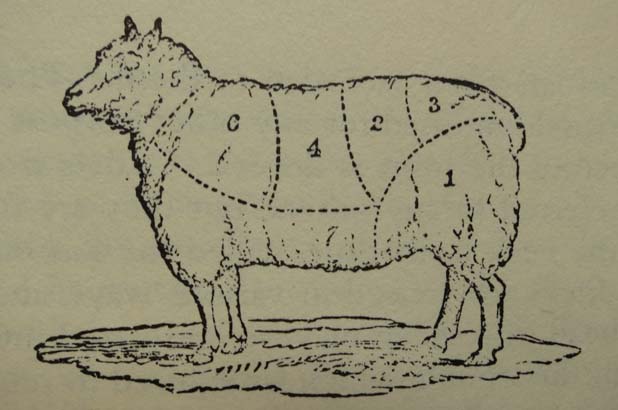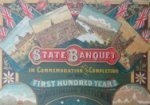Lambast – the Cook’s call to [our coat of] arms!
With the Australia Day holiday weekend upon us, Sam Kekovich is back on our screens (TV, computers, smart phones, ipads and other devices) promoting that iconically Australian meat: lamb. This year’s campaign pitch is ‘lambnesia’ which, according to Sam, “makes you forget what makes this country great and fills your head with a load of un-Australian bulldust. Wake up Australia. Let’s not go off our chops, let’s keep them where they belong – on our barbies and in our hands on Australia Day!” (quoted from MLA media release)
Now in its ninth year, the Meat and Livestock Association (MLA) advertising campaign tells us that not serving lamb on Australia Day is downright un-Australian! But in our patriotic frenzy to barbeque our chops, it appears that we do indeed have a touch of lambnesia! What’s happened to our sense of identity – shouldn’t we be serving ‘downright-Australian’ meat on the day that celebrates our nation?
Australians have sought to stand alone since the colony was established in 1788 – striving for self-sufficiency, fighting for a fair go for convicts, emancipists and the self-made man, campaigning for independent government. I would argue that lamb symbolises politics and power in the most English of styles, harking back to the pastoral era of the 19th century: Australia may have been built on the sheep’s back, but it was the gentlemen pastoralists that stood to benefit – including those who made up the first Legislative Council – the landowning gentry.
Celebratory meat
Admittedly, lamb, or mutton at least, was the first celebratory meat – served by Governor Phillip to his officers to mark British settlement on Sydney’s shores. But it was February! Killed the day before, the meat was riddled with maggots so all attention turned to the bumper rounds of spirits and porter on offer (establishing another great Australian pastime).
True, there is the lovely irony that the nation’s future was established when John Macarthur, father of the wool industry, convinced the British monarchy to grant him a royal flock and pastureland, but releasing sheep onto this land changed the landscape forever. Australia’s ‘squattocracy’ duly spread across the country, pretty much on their own terms, to the detriment of the Indigenous landowners and smaller settlers.
Yet, despite having a flock of 1,000 sheep in 1795, even Macarthur served kangaroo and duck rather than put lamb on his table! (He was too prudent to allow his breeding stock to be butchered).
William Charles Wentworth (Esquire) made a fortune from lamb in the 1840s– not from farming it but by boiling down 1000 sheep a day for tallow – the extensive drought proved that sheep were simply un-Australian.
And look where lamb got our Jolly Swagman, seizing the jumbuck with glee! If it was ‘roo meat in his tucker bag those troopers wouldn’t have had a case!
Australians have created a society based on renewal, where you are not judged by your past but for who you are, here and now. Do we see really want our Australian-ness symbolised with a herd animal, following each other without vision, rounded up and shepherded – a mindless flock, a homogenous woolly mass? Or as a unique, spirited individual who is environmentally suited & deeply connected with its country, and enjoys the freedoms of living in this land? (Well, at least until we shoot it!)
Now in the 21st century we know kangaroo is healthier for us as individuals, and a more responsible choice for a sustainable environment. And how sustainable is lamb for many families, when lamb cutlets can exceed $45 kilo? Yet, according to Mr Kekovich, we should express our patriotism with lamb on the BBQ – how refreshingly Australian!
Let’s congratulate ourselves – we’ve broken the shackles by getting ourselves out of the kitchen to gather round the barbie and to defy the idea of being anything but true-blue.
If Australia Day is set aside to celebrate European settlement of this country, let the lamb chop reign supreme – but if it is to celebrate Australia as the country we’ve chosen as our home and are proud to be part of, let’s bring on the wild colonial boy’s untamed alternative -downright-Australian kangaroo – even if just once a year, to serve on Australia Day.
Kangaroo steamer
Ingredients
- 500g kangaroo fillet, coarsely minced or finely chopped
- 400g speck (or pancetta), finely diced
- 1 onion, finely chopped
- 250ml (1 cup) port wine (or fruity red wine)
- 2 teaspoons salt
- 1/2 teaspoon ground white pepper
- 1/2 teaspoon ground mace (or ground nutmeg)
- 1/2 teaspoon ground allspice
- 2 tablespoons thyme leaves
- 1 bay leaf
- 3 juniper berries
Note
This dish was first recorded in Australia in the 1820s but it is likely to have been in existence well before then. Closely resembling the traditional English 'jugged hare', it's a wonderful example of how colonists adapted their familiar British cookery to native ingredients. Some versions are almost casserole style, but this one, which uses minced kangaroo, is similar to a French terrine, sans pastry. It is delicious with crusty bread, pickled onions or cucumbers and bitter greens such as witlof or endive. Spooned straight from the jar, it makes an ideal addition to a picnic spread.
The recipe works best when made over 2 or even 3 days, allowing time for the flavours to develop, before and after cooking. It is important to use a good-quality jar with an airtight, rubber-sealed lid. Old-fashioned 'clip-top' or Mason-style preserving jars are ideal. You could be very traditional and use a deep ceramic pot, if you can find one, and seal it well with double-lined foil and string, the way you would a plum pudding.
Serves 8 with bread and condiments
Directions
| Put all the ingredients except the bay leaf and juniper berries into a large, non-metallic bowl. Using your hands, mix the ingredients to form a slightly sticky but sloppy mixture. Refrigerate for a few hours, or overnight. Pack the mixture into a clean 1-litre jar to just below the fill line, as the mixture will expand during cooking. Use a table knife to remove any obvious air pockets and place the bay leaf and juniper berries on the top. Seal the jar firmly. Put a trivet in the bottom of a large saucepan or stockpot. This allows water to pass beneath the jar and minimises the risk of its cracking from exposure to direct heat. Place the jar on top of the trivet. Fill the pan with enough cold water to reach three-quarters the way up the sides of the jar. Bring the water to the boil, reduce the heat and simmer for 3 hours, topping up the water to keep the jar immersed to the three-quarters level. For safety reasons, allow the water to cool a little before removing the jar from the pan – take care, remembering that the jar will be wet and slippery. Refrigerate and serve cold, as you would rillettes or a terrine. | |

 Print recipe
Print recipe

